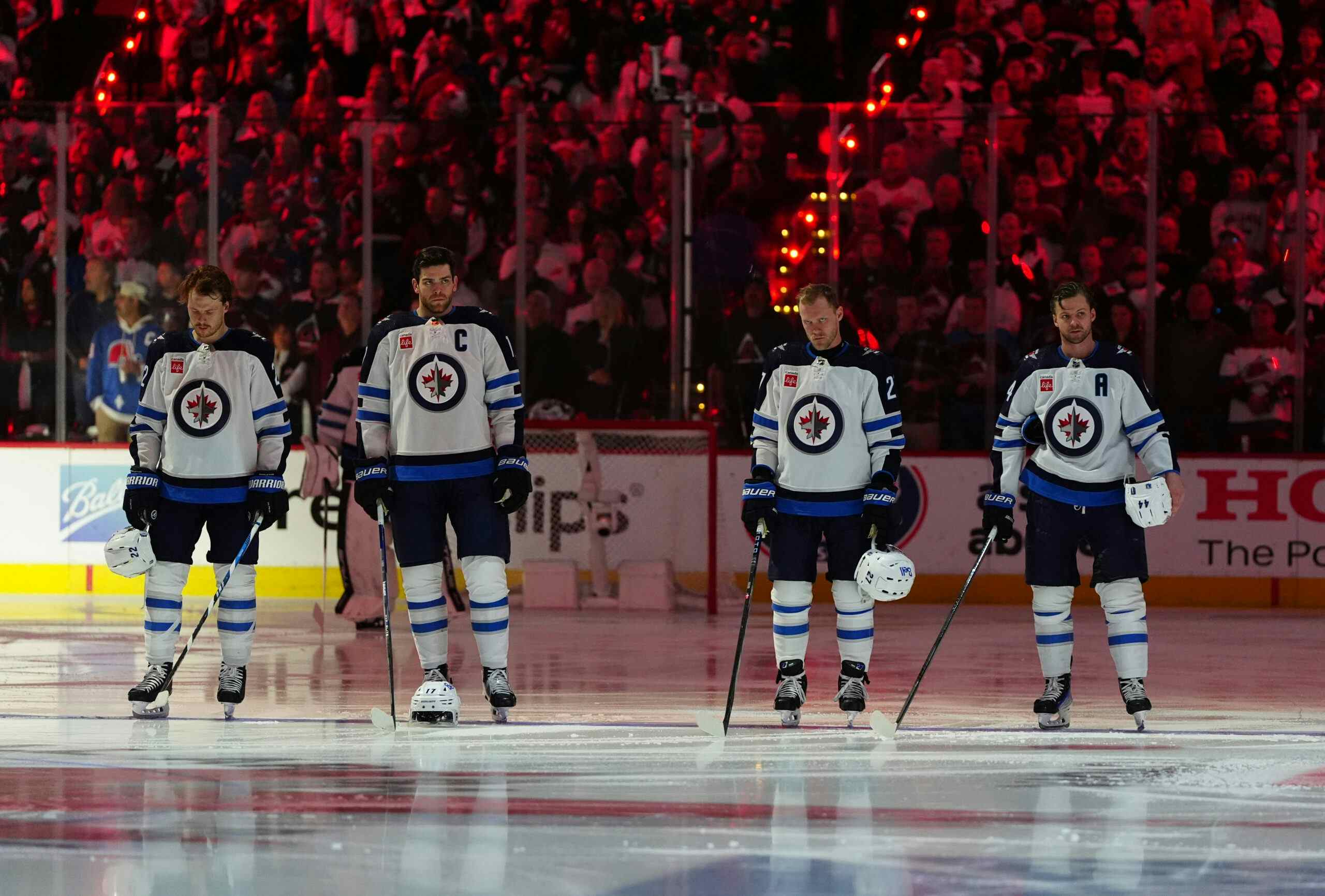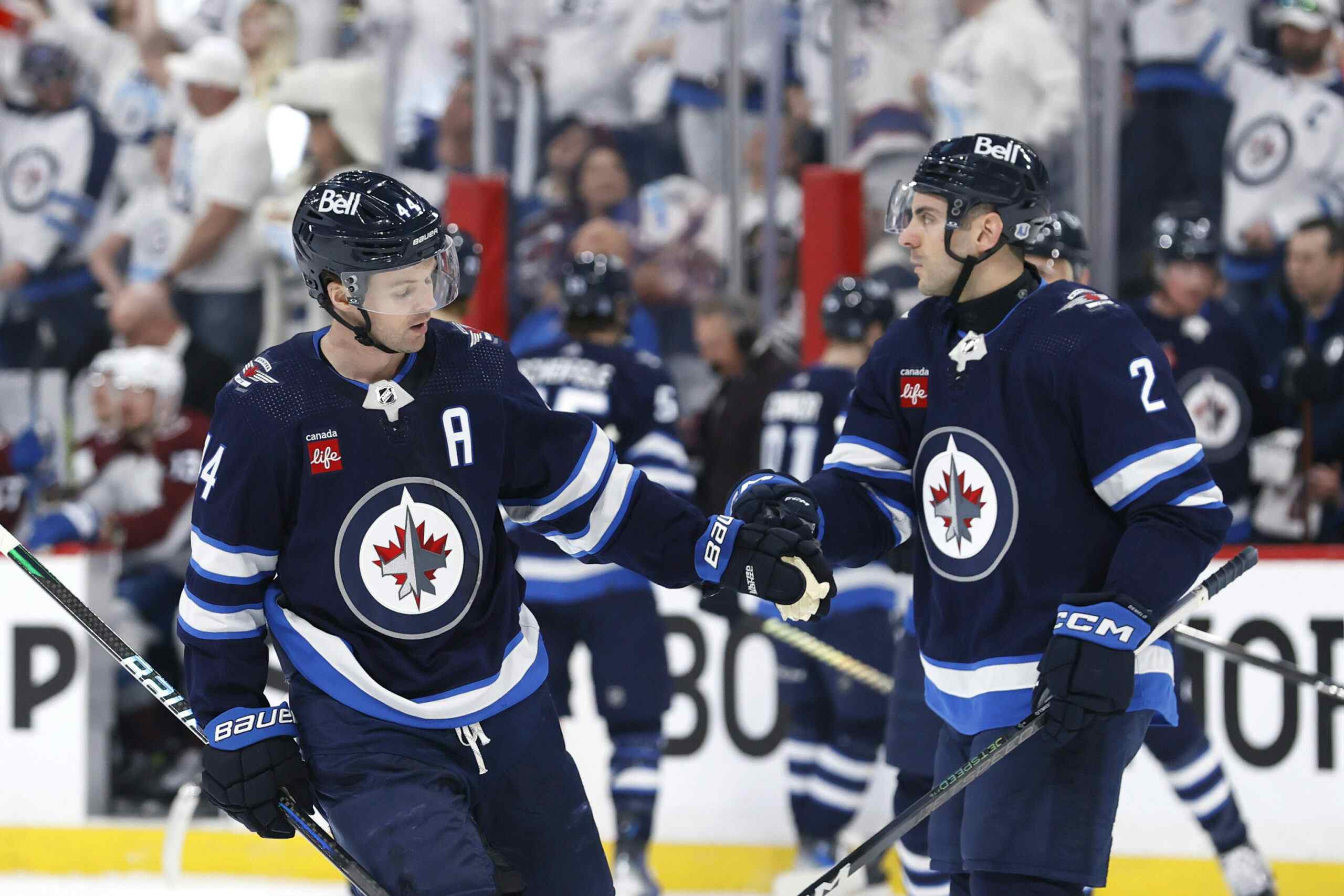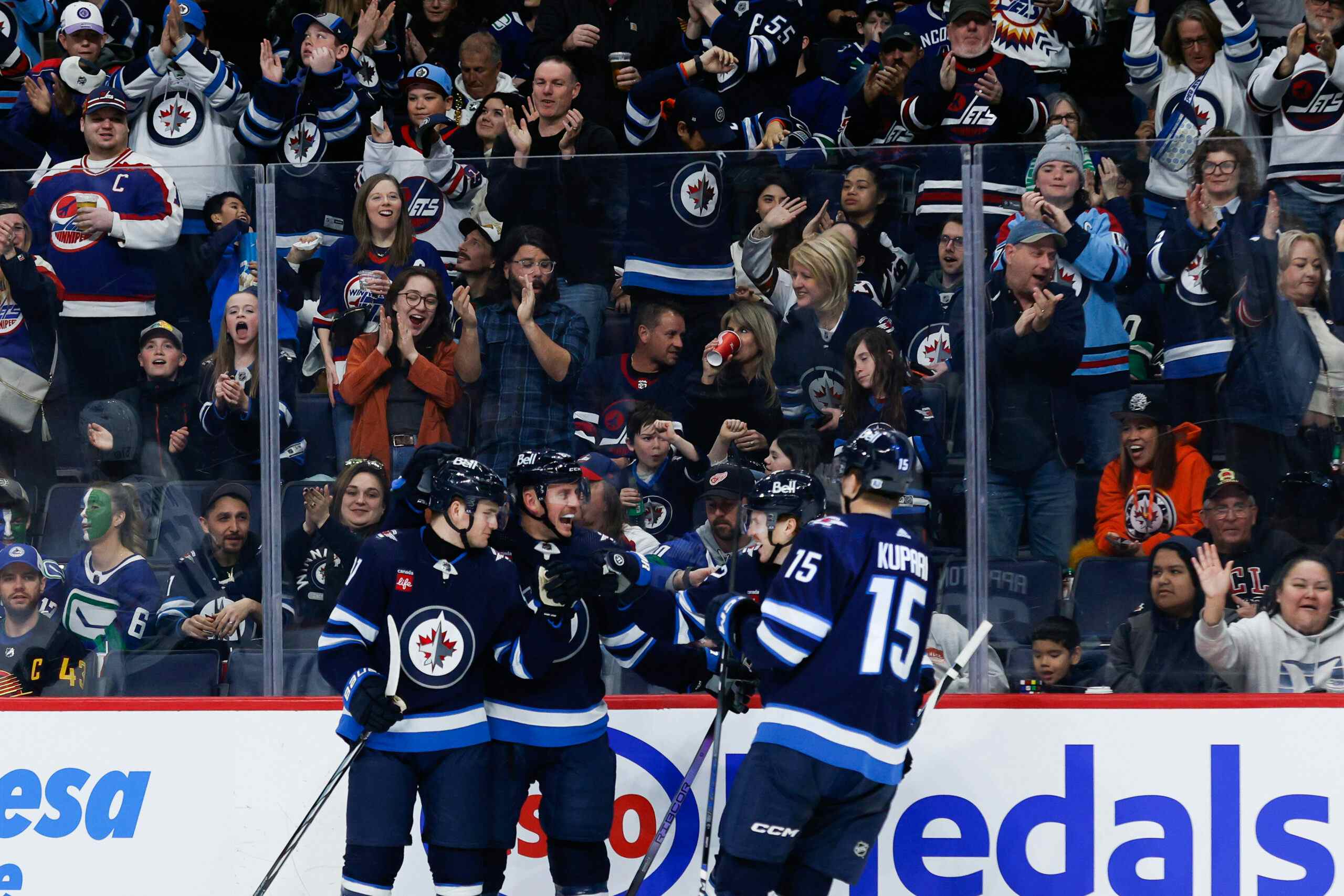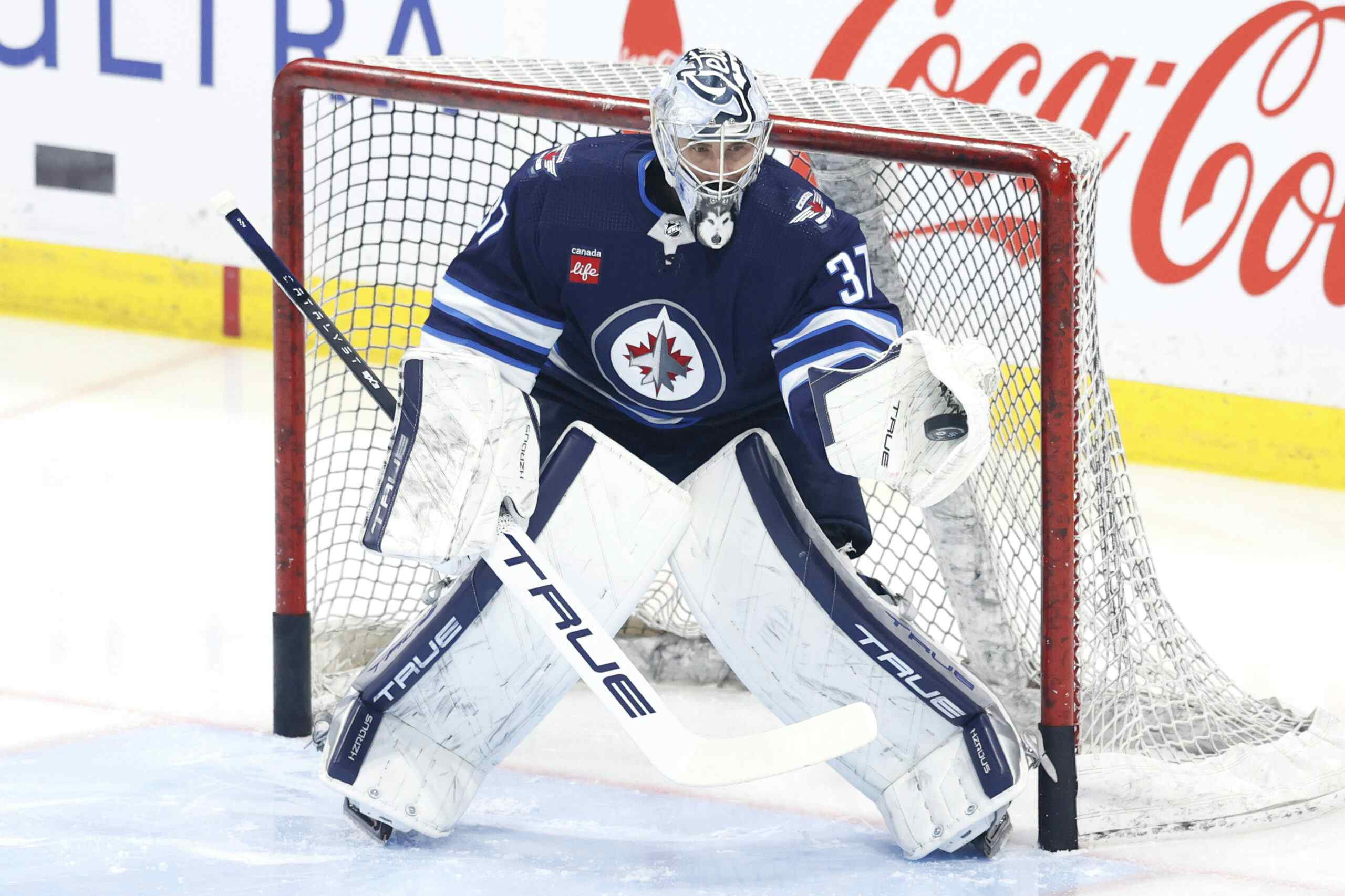Ted Wyman opines to trade Dustin Byfuglien or move to forward, uses terrible evidence
By Garret Hohl
8 years agoTed Wyman of the Winnipeg Sun recently opined that trading a defenceman makes sense for the Winnipeg Jets, and suggested Dustin Byfuglien be the player if they are to do so. He then says, if they do not, they should move him to forward.
And, to be honest, I do not necessarily disagree.
There are some legitimate reasons to keep Byfuglien —which we have previously discussed. There are also some legitimate reasons to trade the Big Buff as well (age, contract, Trouba).
There is not much of anything to support moving Byfuglien to forward.
Let’s take a look point by point and where Wyman went wrong…
Jets depth at forward and defensive
Wyman’s first mistake is when he begins to set up his argument with mentioning a dichotomy in the Jets depth:
The Jets head into camp with 11 defencemen with NHL experience, nine of them on one-way contracts, and a couple more prospects trying to work their way into the mix. They are nowhere near as deep up front, which is why so many people expected to see a trade.
Yes, the Jets have a surfeit of defenders with one-way NHL contracts at defense, while there are available holes — or rather, hole — in the Jets top-nine forwards. However, let’s not not confuse quantity with quantity of quality.

Goals Above Replacement is a holistic statistic that attempts to value a player’s total contributions to the team. The above numbers are 2011-15 numbers extrapolated to a 82 game season. GAR has a tendency to value forwards more so than defenders.
At forward, the Jets have two areas of potential weakness. Drew Stafford has been a negative impact player over the past four seasons, but their is a quality of team factor which the Jets hope are the main culprit. Then the other forward position will likely be covered by one of Nik Ehlers, Nic Petan, or Joel Armia, who are all pushing the NHL for a top-nine role.
At defense, the Jets have three question marks though, which is half the regular roster.
The Jets may have a glut of defenders, but the truth is the quality substantially drops outside of Tobias Enstrom, Tyler Myers, Jacob Trouba, and Dustin Byfuglien. Especially since GAR slightly undervalues the Jets top defenders: Enstrom has been hurt with substantial time with poor GAR performing Zach Bogosian, Byfuglien has minutes as a forward despite performing much better as a defender than a forward, and Trouba has been attached to the hip of Mark Stuart.
The Jets extra defenders do not offer much in replacing Byfuglien’s lost value.
Grant Clitsome has injury concerns and has carried a -1.55 GAR over the past four seasons. Adam Pardy and Jay Harrison come are not much better with -3.00 and -2.97.
Paul Postma (3.25) has been a formidable depth option in sheltered roles and Ben Chiarot (8.24) performed well last season, although there are concerns on how much of this was carried by Byfuglien’s “All-Star performance” this season (likely a lot).
The Jets may have the depth to take a hit from the loss of Byfuglien in a trade. However, the chance of adequate contributory replacement relies on two hopes: that Trouba does indeed develop into a bonafide top-pairing defender and that Myers substantially improves upon his terrible impact on shot differentials, including his time with the Jets.
There is no hope in Byfuglien being adequately replaced by a glut of defenders that have yet to show they should ever play a regular role larger than a depth defender. No, there is no hope in Mark Stuart, Chiarot, Clitsome, Harrison, or Pardy.
The terrible misconception on Byfuglien the forward and the defender
Wyman then follows up with another mistake:
If they are not going to move Byfuglien, the Jets should once again consider playing him at forward, where he can improve the top-9 considerably and is not as much of a liability.
Oh dear.
I understand at times why people think this way. Byfuglien sometimes has defensive mistakes in front of the net and he becomes a very visible villain to blame for goals against.
But at the same time, I have no idea what sport these people have been watching. Byfuglien’s lack of acceleration is far more apparent when playing forward. He chases the play in the defensive zone. Misses his assignments far more often, often even looking lost. He is called upon to backcheck far more often, which is not a strength of his.
The biggest misconception though comes from the difference between defensive competence and defensive impact.
These two things are not the same.
Byfuglien, who is solid against the boards and rarely loses a battle, is far better in defensive competence than many take him for, but the biggest misconception comes from Byfuglien’s defensive impact.
I’ve fortunately have gone over this many times before (each link is an article I’ve written on the subject):
Byfuglien struggles in pushing shots to the outside, so he allows a poor ratio of high quality to low quality shots. However, Byfuglien pushes the play exceptionally well and keeps the Jets in the offensive zone. Because of this,while Byfuglien’s ratio in high to low quality shots is poor, he still ends up with having a positive impact in the number of high quality shots against relative to ice time (and a very positive impact on low quality shots against).
Byfuglien scores more per minute as a defender. The Jets out shoot their opponent with Byfuglien the defender on the ice, but are out shot with Byfuglien the forward on the ice or Byfuglien on the bench. While shot attempts are not a perfect measure, goal differentials regress towards shot differentials.
Byfuglien closely compares to top defenders like Erik Karlsson, Hampus Lindholm, Matt Niskanen, and Aaron Ekblad. As a forward, he closest compares to players like Brad Richardson, Troy Brower, and Matt Fraser.
Byfuglien struggles in entering the offensive zone as a forward and sustaining possession. The Jets generate far more shots per zone entry when Byfuglien is at defense. Byfuglien defends well by rarely ever needing to; not just by sustaining offense, but also by pushing players attempting to enter the Jets defensive zone to the wall where he overpowers the opposition.
Some like to use the weak statistic plus/minus to support their views, but there are fundamental issues in the construction of goals plus/minus: including minutes with goalie pulled, power play minuses, penalty kill pluses, not distinguishing between 2GF/1GA and 22GF/21GA, etc. When looking at 5v5 goal differentials relative to time, Byfuglien may carry a negative goal differential but this is expected with the goaltending the Jets have carried over the past seasons. To account for this, we can see how the Jets goal differential improves with Byfuglien on the ice as a defender relative to when he is on the bench.
The danger between confusing causation and correlation
So then Wyman goes for the kill, trying to create evidence to support his opinion:
The Jets had a much better record last season when Byfuglien was either not in the lineup (9-3-1) or playing forward (16-9-7) than when he was on defence (18-14-5). They have other very capable players who can handle the position and aren’t as risky.
Having an opinion is fine. I may disagree with your opinion, but I’ll fight for your right to hold it. You can be against vaccinations, believe in homeopathic medicine, or whatever. I also will fight for my own right for me to point out when evidence poorly supports opinions, or supports the opposite.
If Wyman wish to use this evidence to say that any team can win without one of their best players, sure, this works fine.
The Pittsburgh Penguins will still win without Sidney Crosby, maybe even more in small samples. It does not mean they are better with out him. You can flip heads on a coin sometimes 7 times in a row.
However, the use of this data to support the idea that the Jets would be better with Byfuglien gone, or at forward, is incredibly faulty. The foundation of the argument relies that the cause for the Jets doing better is because Byfuglien was off the team or at forward.
This is where the argument falls on its face.
It’s well known, even by those who do not delve into the world of sports statistics, that there is a lot of luck in hockey. Hockey is a game of bounces. Sometimes the less deserving team wins.
Hockey is such a close game with so much puck-luck involved that the best team in the league likely only wins the cup once every five years, and misses the playoffs about 2 percent of the time.
The idea that one defender moving off the roster and replacing him with Jay Harrison pushes a team from a 49 win percentage team to a 64 win percentage team is inane. Heck, the idea that Jets truly were a 64 win percentage team and that Ondrej Pavelec was going to carry that shutout streak forever is just absurd.
Just simply look at the evidence above. The Jets performed better with Byfuglien on the ice than on the bench.
How does it make sense that replacing that player with someone with the opposite effect is the cause of the dichotomy?
Byfuglien was still just Byfuglien last season
The next error by Wyman is a bit more understandable:
Byfuglien certainly had his moments last year and was a stud for 12-15 games around the all-star break, but he reverted to his old ways down the stretch, sat out four of the last five games with a suspension and struggled mightily in the playoffs.
A player’s overall impact is their overall impact. If Dustin Byfuglien’s contributions to the Jets probability in winning the game is greater than another defender, the hills and valleys are only the story of what happened. They do not change the actual impact Byfuglien had.
The truth is though that Byfuglien wasn’t really different than any seasons in the past. Byfuglien was still the same ol’ Byfuglien with the same impact.
What changed was the Jets goaltending.
Byfuglien spent the previous three seasons with a goaltender who saved only about 90.6 or less shots against. The Jets last year had 91.2 percent of shots against saved.
While it may seem small, this is a huge swing and has been shown to dramatically change perception of players who experienced these swings. And, before you try and place the blame on Byfuglien, there has not been any evidence that defenders can sustain significant impacts on save percentage relative to their peers. In fact, there is evidence of the opposite.
PDO (on-ice save percentage + on-ice shooting percentage) tends to be used as a gauge for luck. The number is the translation between a player’s shot differential and their goal differential. PDO tends to fluctuate wildly, but regresses to some mean (usually near 100) in the long run. Because of these factors, large outliers indicate a players impact is likely very different than what people view.
Unsurprisingly, Byfuglien’s PDO fluctuates similar to the public opinion on him (and likely also the reason why he was mistakenly moved to forward):

Byfuglien’s “return to old ways” seems to coincide conveniently with his PDO crash, while Michael Hutchinson was struggling to post a single-game save percentage above .900.
And, while Byfuglien was legitimately undisciplined in the playoffs which hurt, Byfuglien was one of the better Jets in Corsi differential and shot differential, and was the best Jet defender in high-danger scoring chance differentials.
It is true that he was statistically worse in the playoffs than in the regular season, but the Jets as a whole were. The best still for the most part had some of the best results.
Everyone is entitled to their opinion, but when you are using evidence you can’t just assume correlation equates to causation and need to look at the underlying reasons.
Recent articles from Garret Hohl





